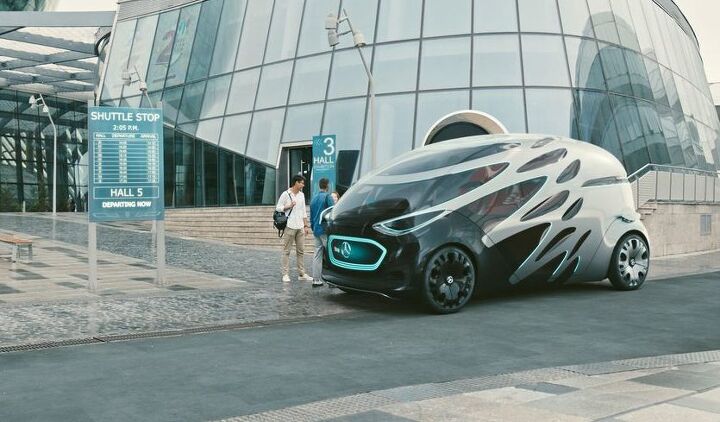Mercedes-Benz's Hideous New Mobility Concept Isn't All That New

On Monday, Mercedes-Benz unveiled the Vision URBANETIC (styled in all caps by the manufacturer) — an all-electric, autonomous nightmare the company claims “answers the questions of future urban mobility.”
The modular design is as versatile as it is ugly. But it’s an important example of the direction automakers are collectively heading. Despite autonomous vehicles being oversold by manufacturers for years, we’re finally reaching a point where they feel comfortable enough to monetize them. Mercedes thinks the Urbanetic will prove revolutionary in redefining our roads. Still, it’s not the newest idea, despite Daimler calling it a “groundbreaking concept.”
Toyota’s e-Palette concept, unveiled at CES 2018, similarly uses a flat, electrified chassis allowing for endless customization. General Motors has the Silent Utility Rover Universal Superstructure (SURUS), which is the same concept applied for autonomous military applications. The General also previewed the AUTOnomy concept in 2002, giving us an early glimpse at what other manufacturers would try in the years to come.
Regardless of who is doing it, the general idea is to put all the mechanical components into a flat plank that’s easy to mass produce and then stack whatever body type you want on top.
For Mercedes, being able to swap bodies is an important part of the recipe. Hypothetical Urbanetic customers will be able to switch the shell manually or via an automatic system — a process Daimler claims would take just a few minutes. Theoretically, you could use the vehicle as an autonomous cargo hauler and convert it into a 12-occupant people mover within the same day.
That leaves the Urbanetic operating primarily as part of a commercial fleet. Mercedes sees the model as a possible solution for local public transit and autonomous urban delivery. The company even noted the platform’s ability to operate 24 hours per day (minus when it’s charging) would be a boon to fleet managers contending with a lack of professional drivers.
Since it’s intended for city use, the vehicle includes large displays on the front and sides to telegraph its intentions to pedestrians. While this is a fine idea, we’d prefer it simply avoid contact with any and all objects in its path. However, that depends on the success of autonomous technology to work flawlessly when scaled up. The industry still hasn’t proven that self-driving vehicles are ready for a primetime slot, leaving models like the Vision Urbanetic to reside in a rather presumptive tomorrow.
Assuming the unit does eventually end up merging with real-world traffic, we sincerely hope Mercedes-Benz redesigns the shell intended for human passengers. It’s one of the homeliest designs we’ve had to endure over the last few years.
[Images: Mercedes-Benz]

A staunch consumer advocate tracking industry trends and regulation. Before joining TTAC, Matt spent a decade working for marketing and research firms based in NYC. Clients included several of the world’s largest automakers, global tire brands, and aftermarket part suppliers. Dissatisfied with the corporate world and resentful of having to wear suits everyday, he pivoted to writing about cars. Since then, that man has become an ardent supporter of the right-to-repair movement, been interviewed on the auto industry by national radio broadcasts, driven more rental cars than anyone ever should, participated in amateur rallying events, and received the requisite minimum training as sanctioned by the SCCA. Handy with a wrench, Matt grew up surrounded by Detroit auto workers and managed to get a pizza delivery job before he was legally eligible. He later found himself driving box trucks through Manhattan, guaranteeing future sympathy for actual truckers. He continues to conduct research pertaining to the automotive sector as an independent contractor and has since moved back to his native Michigan, closer to where the cars are born. A contrarian, Matt claims to prefer understeer — stating that front and all-wheel drive vehicles cater best to his driving style.
More by Matt Posky
Latest Car Reviews
Read moreLatest Product Reviews
Read moreRecent Comments
- Cprescott Doesn't any better in red than it did in white. Looks like an even uglier Honduh Civic 2 door with a hideous front end (and that is saying something about a Honduh).
- Kwik_Shift_Pro4X Nice look, but too short.
- EBFlex Considering Ford assured us the fake lightning was profitable at under $40k, I’d imagine these new EVs will start at $20k.
- Fahrvergnugen cannot remember the last time i cared about a new bmw.
- Analoggrotto More useless articles.






































Comments
Join the conversation
"The industry still hasn’t proven that self-driving vehicles are ready for a primetime slot, leaving models like the Vision Urbanetic to reside in a rather presumptive tomorrow." Sorta like the automobile industry in 1910.
Old city buses get exported to places like Mexico and Guatemala, where they get used for additional decades. These electric concept vehicles will have an unobtainable computer module of some sort go on the fritz, making the whole thing unusable. Third world countries will never get our hand-me-downs. They'll have to make do with new, underpriced Chinese buses.